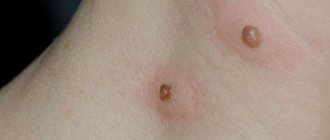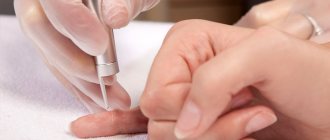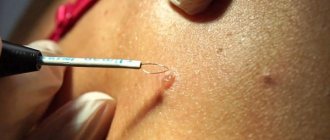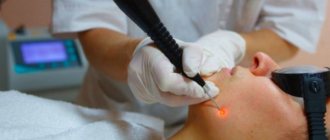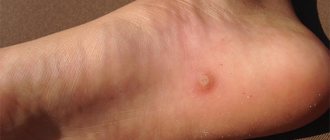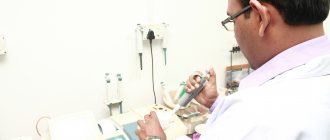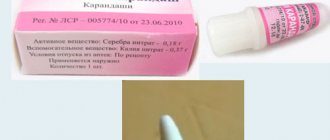There are many ways to remove skin tumors. Radio wave removal of warts is considered the safest and most effective. However, this technique is only suitable for excision of small formations on the surface of the skin. Many warts are considered completely harmless and do not cause discomfort. But if the growth constantly rubs against clothing or is injured in some other way, then it must be removed, since in this case the risk of malignant degeneration increases. In our article we will look at the features of the radio wave method, its pros and cons.
Advantages and disadvantages of radio wave wart removal
Radio wave is electromagnetic radiation with a wavelength of up to 3 THz. No additional waveguides are required for its propagation in space.
In medical practice, millimeter waves with a frequency range of 30–300 GHz are used to remove various vegetations. Radio waves of this frequency do not pose a danger to human health.
Advantages of the radio wave method of treating papillomas:
- non-invasive procedure;
- passes under local anesthesia;
- carried out on an outpatient basis, there is no need for a hospital stay;
- there is no rehabilitation period in the classical sense;
- the procedure is bloodless;
- healthy areas of the skin are not damaged;
- there is no risk of tissue infection;
- no special knowledge is required to care for the wound after the procedure;
- the possibility, in contrast to laser destruction, of histological examination of excised wart tissue.
There are few disadvantages to the radio wave method of removing papillomas, but they should be taken into account when choosing patient treatment tactics.
Disadvantages of the radio wave removal procedure:
- not used to get rid of volumetric elements;
- possible scar formation;
- price;
- the possibility of relapse of the disease.
Advantages
Removing warts using radio waves has its advantages and disadvantages. The advantages of this technique include the following:
- The tumor can be completely removed in one procedure. That is why the high efficiency of the method is considered its main advantage.
- After excision, reappearance of the wart is very rare. The low relapse rate is another plus in favor of the radio wave method.
- The removal operation is carried out in the shortest possible time.
- Since the technique allows you to completely remove raised warts, it is suitable for eliminating plantar tumors.
- The method does not require the use of general anesthesia. To perform the operation, it is enough to administer local anesthesia or topical anesthesia.
- If we compare this method with freezing warts, when they are removed with liquid nitrogen, then radio wave exposure is less traumatic, since the surrounding tissues are practically not damaged. During cryodestruction, a large scar is formed at the site of the wart.
- Cosmetic defects are completely absent, that is, scars are not formed.
- Cryodestruction or laser must not be used in hard-to-reach places. In this case, radio wave excision comes to the rescue, which is approved for use anywhere.
Important! There are not many disadvantages to this technique. The first of them is the high cost of the operation, and the second is that this method of excision is not suitable for warts and papillomas of significant size.
Which warts are best removed using radio waves?
Using the radio wave method, papillomas of any type are removed, except for formations of a significant size. The method is not used for the treatment of malignant vegetations and those in which the process of malignancy has begun with the corresponding symptoms. Using radio waves, all formations associated with HPV are removed:
- vulgar warts;
- flat papillomas on the cervix;
- genital warts;
- plantar spines;
- hanging warts on the neck, under the arms;
- papillomas of any localization.
Removal of vegetation is carried out if indicated. This is preceded by laboratory tests to determine the type of virus, assess the oncogenicity and viral load on the body. If localized on the cervix, an ultrasound examination of the pelvic organs and subsequent removal of warts are indicated.
A course of drug therapy is required to suppress the virus.
Antiviral drugs and immunomodulators, and means for local treatment of vegetation are used.
Reviews
The radio wave surgery technique is ideal for removing warts, papillomas and condylomas. This is evidenced by the reviews of those who got rid of the problem with its help.
Marina “I was really bothered by a large wart on my neck. I didn’t want to remove it by cauterizing it with liquid nitrogen or other chemical methods - I knew it would take a long time to heal. I learned about the radio wave technique, decided to try it and was not disappointed - two weeks after removing the wart, only a small pinkish spot remained on the skin, which disappeared after another two weeks. Two years have passed since then, the skin is still clear.”
Vladimir “I had a wart under my arm, it was very inconvenient when putting on and taking off clothes, I constantly caught them, resulting in irritation. Realizing that it needed to be removed, I discussed possible options with the doctor and settled on the radio wave method. The procedure lasted only 20 minutes and did not cause any discomfort - pain relief was complete. Six months later I forgot about the wart.”
Oleg “When a small wart appeared on my chin, I was always afraid of damaging it when shaving. I didn’t burn it with chemicals, but it was my face. Having learned about the radio wave method, I decided that this was just for my case. I specially took a vacation in late autumn and went to the doctor. They removed it quickly and without pain; when the anesthesia wore off, it was a little painful, but tolerable. The crust fell off after 10 days, and by spring I myself could no longer accurately determine the place where the unfortunate wart was.”
How does the wart removal procedure work?
Need advice from an experienced doctor?
Get a doctor's consultation online. Ask your question right now.
Ask a free question
Radio wave removal of papilloma is carried out in a medical institution. The doctor's office must be equipped with a Surgitron apparatus and an exhaust hood; inhaling fumes during manipulations is dangerous to the health of the patient and medical personnel. The procedure is performed by a dermatologist, urologist or gynecologist. It is prohibited to remove vegetation outside of medical institutions. It is fraught with complications and the inability to provide qualified assistance in unforeseen situations.
No special preparation is required. If condylomas on the genitals are to be removed, it is advisable for girls to carry out the procedure immediately after completion or, at most, 2 days after their period. The patient must inform the doctor about medications taken on an ongoing basis and the presence of allergic reactions to anesthetic agents.
The sequence of manipulations for radio wave removal of warts:
- The patient is seated in a chair; when removing condylomas in women, he is seated in a gynecological chair.
- An aerosol spray of anesthetic is sufficient; conduction or injection anesthesia is not required.
- The location of the formations is separated from healthy areas with gauze or disposable napkins, forming the surgical field.
- The doctor brings the waveguide to the wart and removes it layer by layer. At the same time, small vessels are cauterized, no blood is released, and the wound surface is disinfected.
- After the vegetation is removed, a wound is formed. It is sterile and does not require additional treatment with an antiseptic. Minor pain may be present.
After removing warts using the radio wave method, the doctor will explain how to care for the wound and prescribe medications for treating the skin and mucous membranes.
Indications for the procedure
Before choosing the use of radio waves as the most suitable method for removing warts, the doctor must first examine the patient. This method can be used in the presence of only benign formations.
On this topic
- Warts
All about removing warts with nitrogen
- Inna Viktorovna Zhikhoreva
- September 27, 2020
It is considered advisable to use a radio wave device even on open areas of the body, since the risk of scar formation after wound healing is minimal.
Warts that have the following symptoms should be removed urgently:
- atypical and rapid changes in shape and color;
- burning sensation and pain when touched;
- location that affects the aesthetics of the overall appearance;
- connection with other pathological abnormalities in the body;
- large size and growth.
Doctors also recommend removing warts using radio waves if they are in an unfavorable location. Here it is worth considering points of friction with shoes, clothing or jewelry.
How long does rehabilitation take?
The duration of the rehabilitation period after radio wave removal of warts depends on the location of the papilloma and the volume of intervention per procedure. If the papillomas are located on the skin, then complete healing will take from 7 to 14 days. If localized on the mucous membrane of the genitals, on the cervix, rehabilitation will require 1 month.
The duration of healing is influenced by the patient’s behavior during the rehabilitation period, the quality of care of the wound surface, the absence of inflammation and other complications.
Why do warts need to be treated?
There is an opinion that warts do not need to be treated, since within 1–3 years immunity against the human papillomavirus is formed, and warts spontaneously resolve. This fact occurs, but not in all cases. In addition, during this time, close household contacts may become infected and multiple warts may form, which are much more difficult to treat.
In addition, plantar warts can cause significant discomfort and disability, as they can cause pain when walking. This is due to the characteristics of plantar warts to grow deep into the skin.
The main method of treating warts is removal, which is used as an independent method. In some cases, removal of multiple and recurrent warts is carried out against the background of general therapy. General treatment includes oral tablets or injections of medications that enhance a person's antiviral immunity.
Who should not remove growths using radio waves?
There are few contraindications to radio wave removal of warts. The procedure is prohibited in the following cases:
- if the malignant nature of the neoplasm is suspected;
- without first determining the type of vegetation or conducting a preliminary comprehensive examination of the patient;
- chronic inflammatory processes on the skin;
- acute infectious or inflammatory process in the reproductive system when vegetation is localized on the vulva, cervix;
- presence of a pacemaker;
- allergic reactions of any origin in the acute stage;
- uncompensated hypertension;
- viral, bacterial diseases in active course;
- epilepsy;
- herpes in the active phase.
By taking precautions, the risk of hazardous consequences can be reduced.
The article has been reviewed by the site editors
Contraindications
Radio wave exposure is not recommended in the following cases:
|
|
If you have any of these signs, it is best to postpone the procedure or try an alternative method. Consult a dermatologist first. To do this, make an appointment at the Tatiana Tsymbalenko Center for Trichology and Cosmetology.
Device for removing tumors Surgitron
Surgitron is a device for removing tumors on the mucous membranes and skin. This device from Ellman (USA) was created for radiofrequency surgery. It works by radio waves that increase the temperature in the tissue of a wart or other benign growth. This release of heat specifically hits the cells, essentially evaporating them.
Radio waves arrive at a certain frequency (3.8-4.0 MHz) and are converted from electric current, forming at the tip of the electrode. In this case, there is no direct contact with the skin, and the radio wave knife itself does not heat up. The Surgitron device has proven itself excellently in aesthetic medicine and dermatology as a highly effective and non-traumatic means of removing formations.
The device is also actively used in gynecology for erosions and papillomas of the cervix and in ENT practice for persistent difficulty in nasal breathing. Radio wave coagulation of the inferior turbinates is effective for ronchopathy (snoring) and rhinitis. The operation is performed on an outpatient basis.
In this case, it is necessary that the patient does not have a cold or suffer from bronchopulmonary diseases. Nasal breathing after radio wave intervention is restored after 3 to 4 days, due to a gradual reduction in swelling.
General information about the method
The radio wave method of removing warts involves dissecting tissue and subsequent evaporation of tumor cells using a radio knife
Warts can be removed by applying high-frequency waves to them. The radio wave method of removing warts involves dissecting tissue and subsequent evaporation of tumor cells using a radio knife. Since the surrounding tissues are not affected during the procedure, it is absolutely non-traumatic, which eliminates the occurrence of bleeding. Usually the process lasts no more than 30 minutes. The patient can immediately go home. In this case, it is important to follow the doctor’s recommendations: do not wet the wound under any circumstances, and regularly treat it with antiseptic agents. If the rules are followed responsibly, rapid healing will occur and no scars will remain on the skin. The cost of the procedure depends on several factors. The price is affected by the location of the growths, their number and size.
Removal technology
Before the operation, the patient must be given local anesthesia using a special spray, anesthetic cream or an injection under the base of the wart.
The duration of the procedure is affected by the number and size of growths, but usually the operation lasts no more than half an hour. As soon as the radio wave knife heats up, the doctor quickly cuts off the wart. The tissues that are nearby are cauterized due to the high temperature, and this helps to avoid bleeding.
Then the doctor treats the wound with special means and the patient can go home. At the end of the procedure, the growth can be examined in the laboratory. This will help determine the presence of malignant processes in it.
